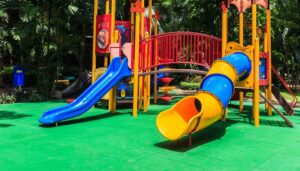Your Guide to Rubber Flooring for Children’s Areas
 Have you ever thought of an outdoor rubber flooring for children’s playground? Even though the rubber floor is expensive, it is worth the investment. Injuries due to rough playground may at times be life-threatening to children and thought torture to their parents. At times, the injuries due to the hard floor surface at the playground may turn severe and disabling. Thus, a great precaution should be taken to reduce the injuries bearing in mind that you cannot prevent the kids from falling, but you can make a landing ground friendlier.
Have you ever thought of an outdoor rubber flooring for children’s playground? Even though the rubber floor is expensive, it is worth the investment. Injuries due to rough playground may at times be life-threatening to children and thought torture to their parents. At times, the injuries due to the hard floor surface at the playground may turn severe and disabling. Thus, a great precaution should be taken to reduce the injuries bearing in mind that you cannot prevent the kids from falling, but you can make a landing ground friendlier.
According to a research by the Center for disease control and Prevention (CDC), about 80% of the injuries in children result from falls while in the playground. The study further states that out of those who visited hospitals for treatment, 20,000 children below 14 years of age suffered play-related injury. Therefore, choosing rubber flooring for the playground means safety to the children and eradicates injury worries for the parents.
Types of rubber flooring
Children playground rubber floor are of three types:
- Rubber floor tiles-These types of flooring are best suited for the playground to those who may need floating floor sports ground. The tiles are fixable without the use of adhesives or double-sided tapes.
- Rubber floor mat-This type of flooring material covers an ample space without installation. The mats are common along the entrance of buildings to prevent slip and falls accidents.
- Rubber floor rolls-Rubber floor rolls are large sheets that you can install in stripes. They are often installed directly on the surface of the new floor or onto the existing flooring.
Advantages of rubber playground floors
1. Durability
Rubber is a resilient flooring material that lasts for up to 20 years if you carry out proper maintenance. It can withstand a varied range of conditions. Regardless of the type of tile or rubber used, rubber flooring is still the most preferred playground flooring material
2. Installation
Rubber tiles are generally easy to install due to some features such as interlocking edge and pin system that holds the tiles together. Alternatively, rubber tiles are soft and can be cut and fixed. Other options, such as glue-down are also available.
2. Recyclability
They are readily recyclable when old. Recyclability makes the use of rubber floor sustainable in nature.
3. Resistance to water
Rubber flooring is water resistant and not prone to water damage. The property makes it suitable for outdoor flooring. Also, its water resistant nature makes it easy to clean.
4. Comfortable
Rubber flooring is soft to feel and cushioned to prevent any form of injury due to fall. Moreover, it provides the traction necessary to maintain foot grip. It is also suitable to play on, walk, and sit its surface.
5. Calm
Unlike other hard floors such as ceramic, rubber floors are elastic, thus makes them quiet to walk and play on.
6. Ease of maintenance
Rubber flooring requires no much resources in maintenance. However, water-soluble wax can be stripped and applied periodically to prevent staining of the rubber. More often, you only need a damp mop to make your floor clean.
Disadvantages of Rubber flooring
1. lack of flexibility
Notwithstanding its benefits, rubber flooring is not as popular as other flooring materials such as ceramic tiles, concrete, laminate, and vinyl due to its cost. The flooring also has very little flexibility, and its application in the homes are limited. It also comes in few color options.
2. high cost
In terms of cost, high-quality rubber flooring is expensive and can only be affordable to a small market segment. Moreover, smooth surface rubber floors can be very slippery and may cause slip and fall hazard.
3. difficult to stain
Rubber floors are difficult to stain, but some strong abrasives and detergents cleaning liquids may have a significant impact on your rubber floor. Therefore, checking on the manufacturer’s guidelines for the use of such material may help reduce the incidences of staining.
4. at times hard to make it waterproof
At times, the material may be installed with gaps underfloor. When such incidences occur, it becomes challenging to make the underfloor waterproof completely. Therefore, you should avoid seams during installation. Furthermore, Rubber flooring is a fire risk in case of a breakout.
There is no single perfect flooring option for children’s playground, but rubber flooring offers the best solution. Thick and shock cushion materials are categorically fashioned to keep kids safe during their jumps from varying heights. Thus, the thickness of the flooring always determines the shock absorbency of the playground floor. The thicker the material, the better it becomes for children.


